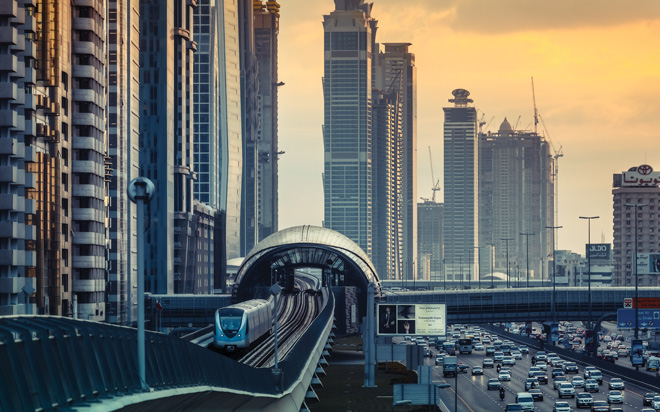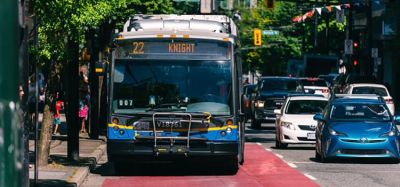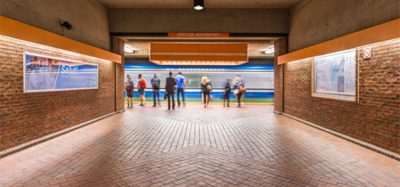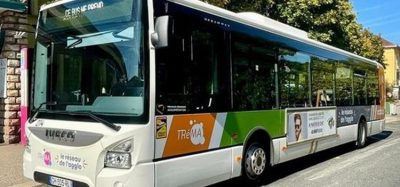Urban public transport developments in MENA
- Like
- Digg
- Del
- Tumblr
- VKontakte
- Buffer
- Love This
- Odnoklassniki
- Meneame
- Blogger
- Amazon
- Yahoo Mail
- Gmail
- AOL
- Newsvine
- HackerNews
- Evernote
- MySpace
- Mail.ru
- Viadeo
- Line
- Comments
- Yummly
- SMS
- Viber
- Telegram
- Subscribe
- Skype
- Facebook Messenger
- Kakao
- LiveJournal
- Yammer
- Edgar
- Fintel
- Mix
- Instapaper
- Copy Link
Posted: 20 June 2016 | Amr Ramadan, Senior Research and Partnership Officer, UITP MENA Centre for Transport Excellence | No comments yet
Despite political and financial instability, in an effort to combat endemic congestion and environmental challenges, cities across the Middle East and North Africa are still pushing forward with mass public transport projects including BRT, metro, light-rail and cable car transport. Most cities have laid out urban mobility plans to make MENA cities more liveable and improve quality of life for their citizens. North African countries are now setting up powerful governmental authorities to plan and integrate public transport strategies and empowering them with proper financial support…


In the Gulf Cooperation Council (GCC) region, where private vehicle ownership is traditionally high and increasing rapidly, public transport authorities are aiming to facilitate a modal shift towards public transport. This may be an opportune moment for public transport in the GCC, as governments are now slashing fuel subsidies, many for the first time ever, in parallel with significant investment in public transport infrastructure and expansion projects.
Nowhere in the region is this more evident than in Riyadh, Saudi Arabia, where the local government has made plans for an integrated network of metro, bus and BRT. This started in 2012 when the public transport project for Riyadh was approved (King Abdulaziz public transport project) and mid-2013 marked the official launch of implementation. The project consists of two components: Riyadh Metro and Riyadh Bus networks. Riyadh Metro comprises six metro lines with a total length of 176km, 85 stations and 190 trains. Driverless trains will be used to run this project which the government claims is the biggest public transport project to be constructed all in one go. Riyadh Bus on the other hand will operate a total of 1,000 buses of different types and capacities. According to RATP DEV and SAPTCO, who won the tender to operate the bus network, it will have a fleet of 1,000 vehicles, four Bus Rapid Transit lines, two circular lines, 16 community lines and approximately 70 feeder lines. The bus network will be integrated with the metro network to create a comprehensive integrated public transport system1. Similar plans are being made for bus and rail projects in the Saudi Arabian cities Jeddah, Mecca and Madinah and Dammam.
Dubai has already made significant strides in public transport with its famous fully-automated driverless metro system – the largest in the world. There are now plans to extend the network even further and The Roads and Transport Authority (RTA) are now building a 14.5km-long ‘red line’ dubbed ‘Route 2020’ and are set to better connect the city to the upcoming 2020 Expo. The number of stations on the entire network is set to increase from the current 47 to 70 by 20202. Dubai is also constantly developing its bus network by increasing the number of bus stops, dedicated lanes, routes and the number of available buses in a plan to reduce congestion. In 2010 and 2011 Dubai introduced 7km of dedicated bus lanes and is now discussing the possibility of fully segregated BRT lines. In 2015 the RTA made plans to build 400 air-conditioned bus shelters in the city3.
However, the most interesting development in Dubai is its new adoption of technological mobility solutions as well as the traditional ones, such as bus and rail. In April Dubai’s ruler, Sheikh Mohammed bin Rashid Al Maktoum announced that, by 2030, 25% of all trips on its roads would be taken in driverless vehicles, cutting costs, travel times and supposedly improving safety levels on the city’s main highways4. It would also maintain Dubai’s regional role as the vanguard of the region’s push towards public transport.
With Qatar expected to host the World Cup in 2022, the capital, Doha, has also begun building a metro system. The project is set to serve both the capital and the suburbs, enabling all major locations to be within easy and convenient reach. According to the project website, the metro system will be built in two phases: the first will see the construction of three out of the four lines (Red, Gold and Green) as well as 37 stations. These lines are expected to be open to the public by 2019/2020. The second phase will be completed by 2026 and will involve the expansion of the phase one lines, and the construction of an additional one – the Blue Line5.
Better marketing of public transport is also a key issue in a region (in the case of some countries) where traditional operators are viewed as run-down and out-of-date, necessitating modernisation and better service as well as better outreach and information provision. In Oman the state run ONTC (Oman National Transport Company) which was founded in 1972 was recently rebranded to ‘Mwasalat’. The current fleet of Mwasalat now has 574 vehicles comprising mini buses, low-floor buses, long-distance coaches and super luxury coaches. The fleet is supported by a network of 11 branch offices, 13 agencies and 700 staff. The new expansion also features a fleet of 40 brand new VDL buses on the five different routes, operating between 6:00 and 22:00, in headways varying between 15 to 20 minutes. Additional routes are expected to be introduced in 2016. More than 60 bus stops have been planned. The rebranding involved changing the colours and identity of the brand, the logo, and even bus livery. In addition, the company now uses the slogan ‘Sit back and enjoy the ride! Mwasalat keeps you moving’ promising to attract and encourage people to use public transport by offering an efficient world-class infrastructure, amid safe and environmentally-friendly services for achieving increased land connectivity and reduced congestion6. Preliminary surveys indicated the success of the rebranding effort leading to favourable results in terms of ridership and customer satisfaction.
One of the major planned projects in the GCC is the Etihad Rail network. The 1,200km-long network is planned to extend across the United Arab Emirates, from the border of Saudi Arabia to the border of Oman. Etihad Rail is set to have an extensive national network with freight terminals, distribution centres and depots located close to major transport hubs, warehouses, and storage facilities across the UAE. According to a recent press release, construction of the 264km-long Stage One line running in the UAE had been completed in 2015 and the rail line transported more than 2.5 million tonnes of granulated sulphur in its first year during the testing, commissioning and trial operations phases. The next phases should connect with the GCC network extending to The Kingdom of Bahrain, The State of Kuwait, Oman, Qatar, The Kingdom of Saudi Arabia and UAE7. The effect of the current oil price drop on GCC governments budgets, however, have led to delays in the construction of these phases in the respective countries.
Elsewhere, North Africa – particularly the Meghreb region – is also investing heavily in public transport with the help of government led financing schemes and new organisational structures. The Morocco government, aiming to support cities, has shifted towards new governance frameworks that focus on bringing together districts from the same metropolitan area under the same financing mechanism. They created local development companies (SDL) tasked with investing and making contracts with private operators to set up public transport projects in Casablanca, Rabat, Marrakech, Agadir and Tangier. The funding for these companies comes from the special fund for transport reforms (FART) which, with the districts, jointly funds the initial investments and handles the loans taken out. Moreover, these funds can help with the operating deficits for projects in the cities during the first three years of operation8. Morocco is now extending its tramways in Casablanca and Rabat, building a four-line electric BRT system in Marrakech, and are now in the concept stage of designing seven dedicated bus routes in Casablanca.
In Algeria, in an effort to modernise transport companies and improve services through self-management, the Transtev group (public group of land passenger transport), was established earlier in 2016 and includes EMA (rail system), SETRAM (tram system), ETAC (cableway system), Sogral (bus system) and five subsidiary passenger bus services. Algeria are now focusing mainly on tramways which are now being built in the cities of Sidi Bel Abbes (2016), Setif (2016), Ouargla (2017), Mostaganem (2017) and are planned in Batna, Annaba, Constantine and Oran. The 20.8km-long Algiers metro is also under construction and should be launched by 2019.
Finally, in Amman, Jordan, the Transport and Mobility Master Plan for Amman has been launched with the vision of ‘building an integrated, accessible, affordable, safe, sustainable and environmentally-friendly transportation system’ by 2025. A 32km-long BRT line from Amman to Zarqaa is currently under construction and is set to be launched in 2018.
With all these significant investments and projects, it is clear that governments in the MENA region are actively prioritising urban mobility over traditional trends of road and highway network expansions. Whether political or financial instability will affect the current situation remains to be seen. However, it seems that governments – whether middle income or traditionally oil rich – have realised the importance of public transport for improving the health and economic welfare of citizens and businesses in cities within the current context of rapid urbanisation, expanding populations, and rising pollution and congestion rates.
References
- Investment and Prioritization of Public transport in Saudi Arabia- ENG. Abdulaziz Alsalem – Business Sector Director – SAPTCO – Saudi Arabia
- raillynews.com/2016/surprise-low-bid-dubai-metros-route-2020
- emirates247.com/news/emirates/dubai-to-get-400-ac-bus-shelters-this-year-2015-01-11-1.576075
- abcnews.go.com/Technology/wireStory/dubai-pushes-pedal-metal-driverless-cars-38658663
- qr.com.qa/English/Projects/Pages/DohaMetro.aspx
- mwasalat.om/en-us
- etihadrail.ae/en/about/etihadstory
- UITP Trends Report 2015
Biography
Amr Ramadan is the Research and Partnerships Officer at UITP MENA Centre for Transport Excellence where he is currently conducting research on transport mobility indicators, administrative and regulatory reforms in public transport and informal public transport in the MENA region. Amr has a diverse and significant policy research background. After studying Economics at the American University in Cairo (AUC) as an undergraduate, Amr continued his academic career by completing a Master’s degree in Public Policy and Administration at AUC specialised in Management of Public Sector Reform. His Master’s thesis titled ‘Towards Reforming the Regulatory Environment and Policy Structure of the Paratransit Microbus System in the Greater Cairo Metropolitan Area’ and his work as a Policy Consultant with the Egyptian Ministry of Transport allowed him to research topics related to public transport, urban mobility, transport regulations, government bodies and transport policy and informal transport through studying best-practices in Africa, Latina America and Asia. Amr has eight years of work experience on advocacy and public policy and worked for three years on several different short-term contracts as a Policy Consultant at FAO UN at the Regional Office of the Near East (RNE), conducting research and high level policy work on food security, agricultural development and aid for 19 countries in the MENA region. Before that, Amr was the Research and Documentation Manager at the Informality Research Project in Cairo, a project funded by Ford Foundation and UNDP, and implemented by AUC. He coordinated a research team of Professors from the school, working on various topics related to the informal sector in Egypt in terms of housing, economy, transport and legal reforms. At the Egyptian Center for Economic Studies, Amr assisted research on various topics including subsidies, trade, investment policy reform and privatisation. Over his career, Amr has carried out internal policy consulting with ministries of transport, housing, agriculture, investment and foreign aid.
Eurotransport’s next international instalment will focus on developments in Asia written by Sue Chan, the UITP’s Head of Asia-Pacific. Make sure you receive Issue 4 2016 published in August 2016 by becoming a subscriber today – visit www.eurotransportmagazine.com.
Related topics
Business Models, Infrastructure & Urban Planning, Multimodality
Issue
Issue 3 2016
Related modes
Bus & Coach, Metro
Related cities
MENA, Saudi Arabia, United Arab Emirates








